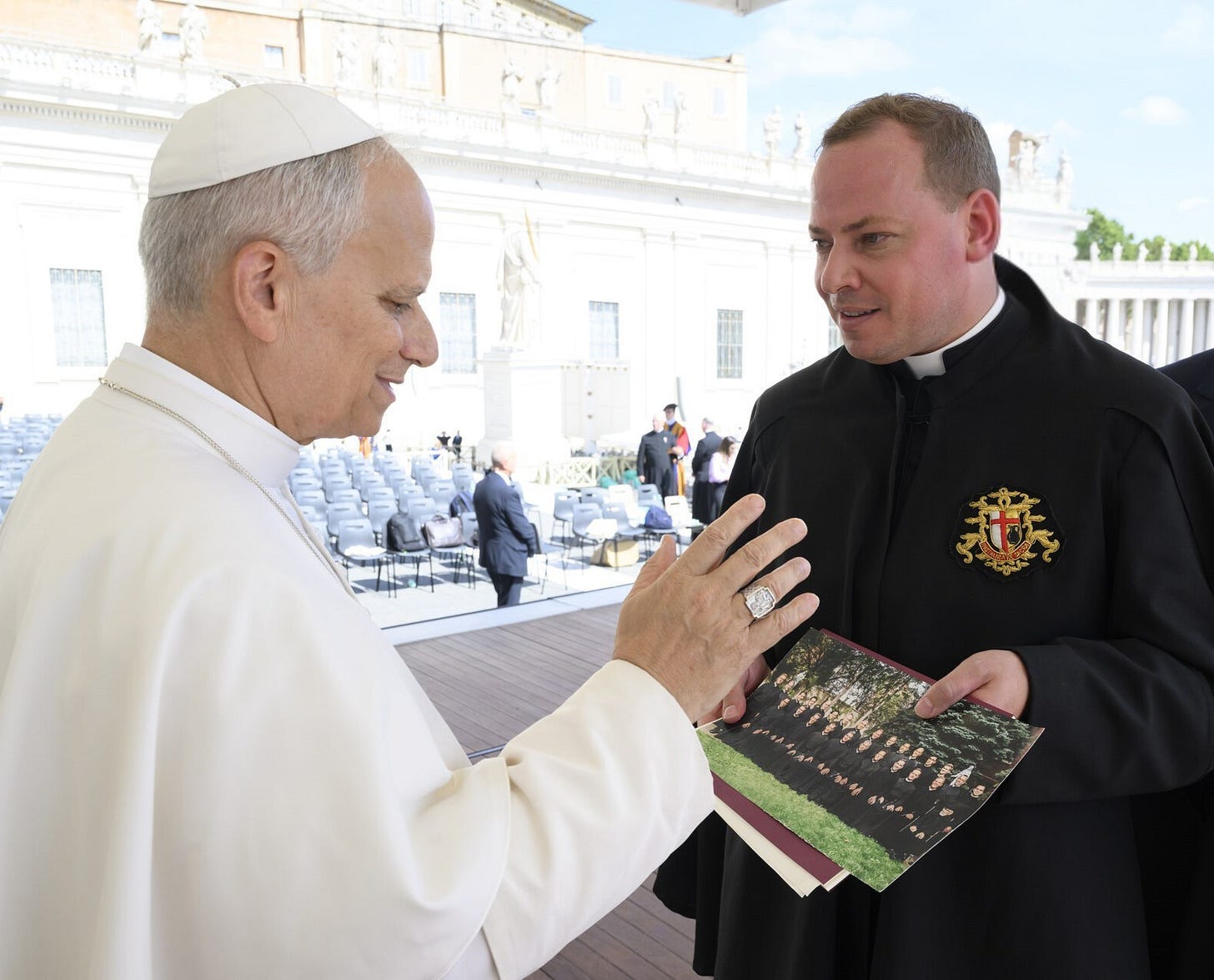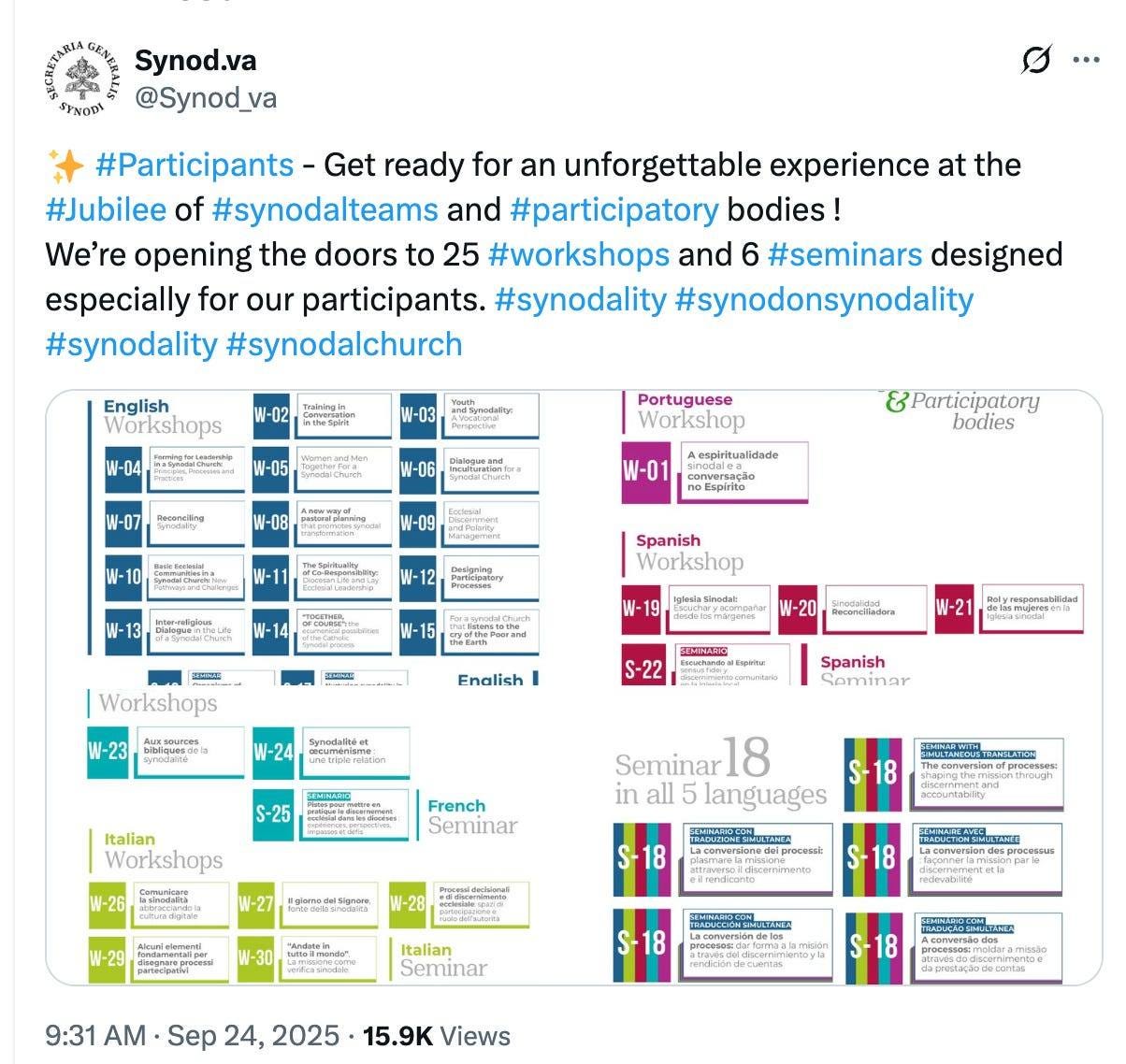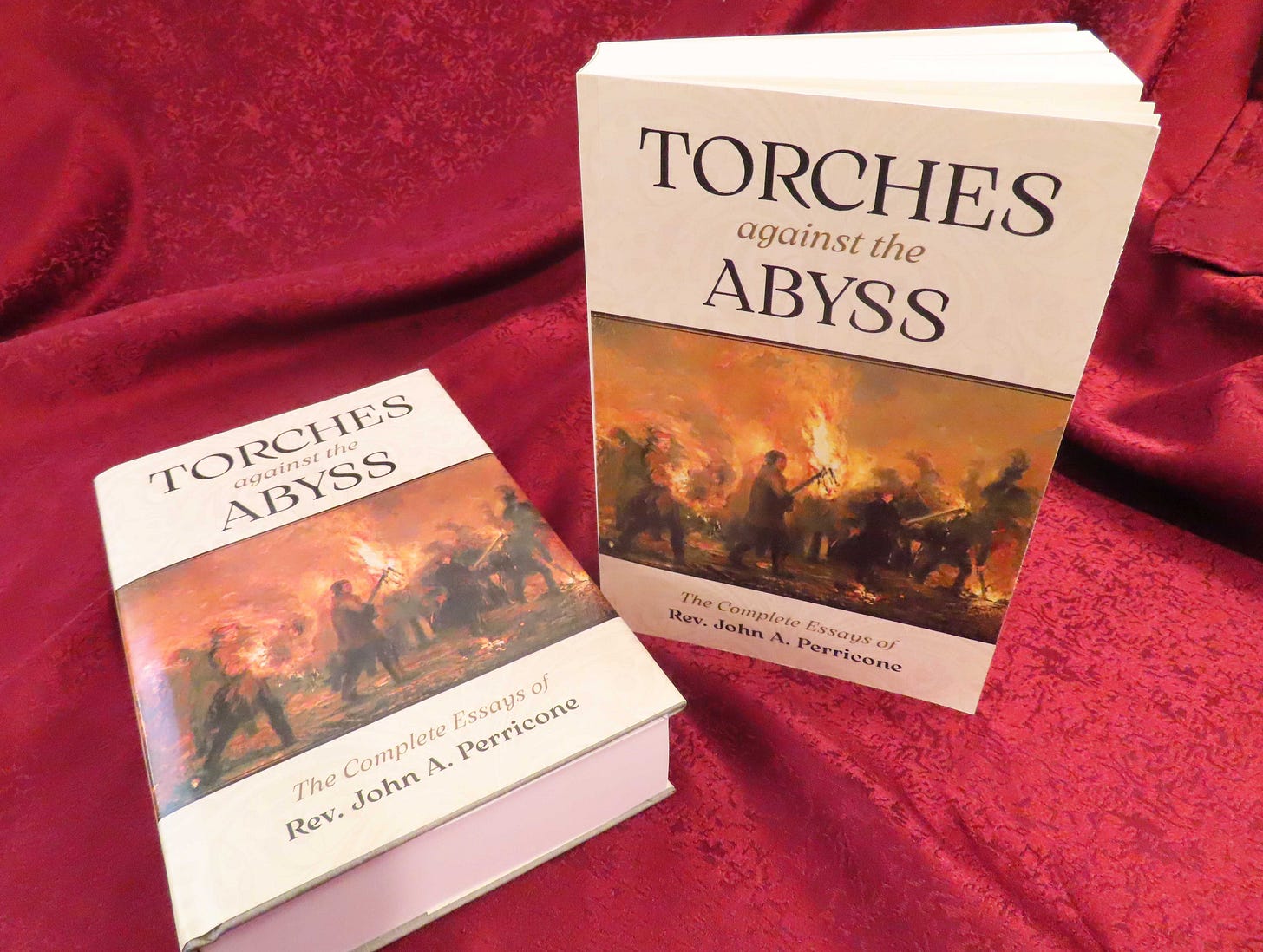Dr. K’s Weekly Roundup, September 26, 2025
Pelican+; the Cupich Axis; TLM good news and bad; Synodality lurches on; LCD ecumenism
Pelican+
I will have much more to say about this as time goes on, but I’d like to announce here a very exciting new endeavor in which I am involved as a founding collaborator: a traditional Catholic media platform launching October 7, called “Pelican+.”
Think: Hallow + YouTube + Substack.
The Traditional Catholic Renaissance needs a central hub online, and one that cannot be deplatformed or controlled. Pelican+ will host the best traditional Catholic content anywhere: podcasts, videos, articles, audio books, ebooks, prayer apps, without invasive secular advertising or messaging.
An initial teaser:
To see the founding team, visit here and scroll down a bit.
Why are we giving it the name “Pelican”? Here’s my answer (in a minute-and-a-half):
In light of which, it was a sheer delight to receive in the mail a letter bearing a wax seal of a pelican (on a matter totally unconnected with the foregoing):
Why don’t people still use wax seals? I loved them back when I was a pipe-smoking, tweed-wearing grad student in Washington DC… but I’ll admit that I haven’t used them since.
Regarding Pelican+, stay tuned for updates about how this platform will bring greater benefits and “bang for the buck” to the users. Rest assured, the Tradition & Sanity content you know and love will continue, long into the future!
Brave bishops vs. crazed cardinal
In the news this week is Cardinal Cupich’s announcement that, at a November 3 ceremony, he will bestow a “Lifetime Achievement Award” on 80-year-old Sen. Dick Durbin (D-IL), one of the most notorious pro-abortion politicians in the USA.
Archbishop Cordileone and Bishops Paprocki, Conley, and Ricken all spoke out publicly against Cupich’s proposed action. This is good: they were unequivocal in their condemnation. But where are all the others? Why just a few “lone rangers”? Are they the only believers left?
It’s not like we’re talking about fine points here. We’re talking about a senator who has supported atrocities like partial-birth abortion and denying care to babies born alive after failed abortions. Sheer barbarism.
Anne Hendershott points out that a failure of the USCCB as a body to intervene to prevent this enormous scandal is a sign of the bishops’ total moral bankruptcy.
At Catholic World Report, Jayd Henricks writes in his scathing piece “The Scandalous Case of Cardinal Cupich and Senator Durbin”:
Cardinal Cupich is his own man, and he has proven many times that he is willing to go his own way, or the way of a small minority of bishops, and create division. Perhaps he has the smell of the sheep, but his sheep tend to huddle in the far-left corner of the yard.
I do not know Cardinal Cupich personally, but I have been around him enough to have a sense of the man. He was my rector at the seminary for first-year theology, and even then, in 1995, he went his own way. I remember one evening he cancelled all classes and pastoral activities for a special convocation, something unprecedented for the seminary. He called us together to announce he had been made a monsignor. I felt bad for him then because I thought about how isolated he must be to believe that any of us cared....
When I worked at the USCCB, he did not hold any significant leadership positions. He could not get elected due to how unpopular he was (and remains), and yet he frequently muscled his way around with staff. He created a climate of fear, so familiar during the Francis pontificate, that impacted the daily work of lay staff.
On the Latin Mass front
As usual, there’s a mix of good news and bad news.
Over in Detroit, Archbishop Weisenburger continues his irrational campaign, not only violating canon law himself but demanding that his clergy violate it as well, as explained here by “Frater Spiritus.”
Once again, and always:
1. No priest needs a bishop’s permission to offer the TLM privately.
2. No priest needs a bishop’s permission to allow the faithful to attend such a Mass.
For review:
“Does a Priest Need Permission to Offer the Traditional Latin Mass?” (Answer: no.)
“Can a Bishop Restrict a ‘Private Mass’ in the Usus Antiquior to a Priest and a Server?” (Answer: no.)
May God grant our clergy the courage to act according to a well-informed conscience, according to legitimate law and tradition. It is time for martyrs (witnesses), not for accomplices and collaborators with the “prison-guards of treachery” (custodes traditionis).
In a move that would win its perpetrator an award for pettiest and nastiest of human beings, Bishop Daniel Garcia, four days before he left his diocese of Monterey, California for his new diocese of Austin, Texas, officially shut down the 17-year-old TLM in Monterey. Take that, you vermin! The Catholics of Austin had better prepare for the worst. (That will probably mean going to the SSPX, which is building a large, beautiful church in the area.) The same Bishop Garcia, wishing to transmit a message of unity and joy to his new archdiocese, made it one of his first acts to cancel a scheduled TLM at Texas A&M University.
So, that is the bad news. But over in Reno, Nevada, a new parish, the Oratory of St. Joseph, was opened for the Institute of Christ the King. Thank God at least some bishops “get it”!
I’d only add that the bishops cannot be unaware of the ever-increasing body of research showing that Catholics who attend the TLM are stronger in faith across the board, especially when it comes to Eucharistic belief and practice. Even mainstream sources are reporting on this now. So, my conclusion is that bishops who oppose the TLM must be either stupid or wicked—that is, either they are cretins who can’t grasp simple evidence, or they are apostates seeking to undermine the Faith.
Probably the most remarkable piece of good news this past week was the publication of a glowing pro-TLM article in the National Catholic REPORTER (i.e., the archheretical Fishwrap), which Rorate Caeli describes as “the bastion of extreme liberalism in America… the epitome of Boomerism and cringy radicalism, as out-of-date as a felt banner.” Well, in this case, it seems they’re not out-of-date! I actually wouldn’t be surprised if their subscriptions are cratering and they realize the need to inject some curb appeal.
Anyway… the article was written by Roxie Beckles (also known as “That Black Catholic Chick”). Here’s a taste:
One of the most painful divides in the Catholic Church today is around how we worship. But when we really listen to the hearts of young Catholics, we see that the desire for tradition is not about ideology, but identity. It’s about feeling rooted in something eternal when the world keeps shifting beneath our feet.
In my opinion, the traditional Latin Mass, with all its ritual precision and theological depth, continues to draw young Catholics precisely because it refuses to compromise the signs of the sacred. The use of Latin, incense, chant, sacred silence and the like are not frivolous or outdated. They engage the whole person — body, mind and soul — in an act of worship that lifts us out of ourselves and into the presence of God.
Young people want a liturgy that reflects the weight and glory of what we profess. They want to hear sacred music that stirs the soul rather than mimic the culture outside the church walls. They want to see beauty. They want to be caught up in mystery.
To move forward as one body, we have to stop pretending that reverence belongs to the past when, in fact, it’s one of the only things still bringing young people in. The future of the Catholic Church depends not on reinvention, but on deepening. We don’t need to discard what’s still bearing fruit. We need to water it, tend it and let it flourish.
My hope is that this pontificate offers space for that to happen; that we won’t be asked to silence what gives life, but invited to share it freely and joyfully with the world.
Very Rev. Joshua S. Caswell, SJC, the Superior General of the Canons Regular of St. John Cantius (headquartered in Chicago), met with the Holy Father Pope Leo XIV after the General Audience on Wednesday, September 17, 2025. The imbalance in the universe caused by the archbishop of Chicago was thus partially corrected:
This next item is both bad news and good news: on the one hand, we have a much bigger problem than most people realize with priests getting canceled for their orthodoxy, their adherence to tradition, or their whistleblowing; on the other hand, these intrepid priests are often stepping up to minister to some of the most deprived and abandoned Catholics out there, namely, the traditionalists.
Recently four canceled priests held an interesting roundtable discussion: Fr. John Lovell, Fr. Vaughn Treco, Fr. Michael Suhy, and Fr. Clay Hunt (The Cowboy Priest). Consider helping the organization Unprofitable Servants, which gets priests back on their feet and ministering to the faithful. In my opinion, this would be a very good use of tithing money.
Synodality lurches on
Rod Dreher commented on the following post on X: “The world is on fire, and these ecclesial bureaucrats are having meetings.”
Yes—even if the rest of the world has forgotten about or grown bored with “synodality,” the ad hoc, ad lib machine cranks on.
Fr. John Perricone addresses this nonsense in his latest at Crisis, “Tiring of God”:
Synodality is the most recent in a long line of embarrassing experiments of the past half century. It seems as though the Church’s leaders have one rule: if an experiment has failed because of its absurdity, the next one must be made more absurd.
An older generation of Catholics can bear this out. They must admit an embarrassing familiarity with such lovelies as: Call to Action, Nuns on the Bus, The Archdiocese of Los Angeles Religious Education Congress (still enduring with all the risibility of an octogenarian wheelchair race), Confessional Rooms, Lenten Rice Bowls, The St. Louis Jesuits, Liberation Theology, Seamless Garment and multi-colored clerical shirts. But that is only a sampling. Others have mercifully been forgotten or should be.
The net effect of these experiments is empty pews, shuttered churches, desolate seminaries, and the almost entire collapse of religious orders. A more dramatic case in point is the decades-old détente the European bishops conducted with Islam. It has resulted in wrenching violence, the burning of churches, and the near disappearance of any Catholic presence.
Only yesterday [Sep. 22] the once papabile Cardinal Parolin warned Catholics to not tip over into intolerance due to the murder of Charlie Kirk. Imagine him preaching that about blacks garroted by the Ku Klux Klan, or homosexuals thrown from the tops of buildings by Muslim jihadists. In reality’s piercing light, the benighted cardinal’s words are shown for the oratorical litter they are.
Father goes on to analyze the problem in terms of acedia or spiritual sloth, a tiring of the things of God and the spirit, and a turning toward the world and the flesh.
If you enjoy Fr. Perricone’s writing (and who doesn’t—who wouldn’t?), allow me to remind you that Os Justi Press has just published his lifetime essays in a splendid book worthy of long lingering:
Speaking of books… Os Justi Press is the exclusive US distributor for Mysterium Press in the UK, which is bringing out beautiful, newly-typeset hardcover editions of the classic biographies of Hilaire Belloc. Two new ones have been released: Cromwell and Charles I (a perfect pairing!).
The road not taken
So, why exactly did Catholics after Vatican II decide to focus their ecumenism on LCD (lowest-common-denominator) Protestantism instead of a holy rivalry with Orthodoxy? Here’s a photo from a gallery published at NLM of a recent trip to Mount Athos made by a friend of the editor’s. Imagine walking into a church like this for your Sunday worship:
At First Things, Anselm Audley, an Anglican ex-chorister reviews a new book on medieval liturgy. In the course of the review, he expresses so well what Catholic proponents of the Big Fat Lectionary never seem to get through their heads: reading a lot of text at people is NOT the way liturgy will be transformative.
I have never met liturgy in the Catholic Church with the range, variety, or depth of feeling that I grew up with, and that Gillhammer describes. Feeling is neither an unfortunate side effect of liturgy, nor a poor second to correct ecclesiology. A liturgy, or indeed a church, that doesn’t allow room to express the full range of human experience will be abandoned for something that does. Writing of changes to the funeral service after Vatican II, Eamon Duffy remarked:
|| One of the principal functions of liturgy is to allow us to pray all our thoughts and feelings, to acknowledge before God what we really are, not to suppress and sanitize our innermost selves and only bring to him what is acceptable and theologically correct. The bitter note of protest is surely one of the most basic of human responses to death, and one of the most legitimate…echoed in the cry from the cross, “Why have you forsaken me?” and elsewhere. We need to come to the knowledge that “my redeemer liveth” but we need also to be allowed to rage against the dying of the light. The old liturgy made space for both: the new does not. ||
In just this vacuum, this refusal to allow room for old terrors and dark feelings, a cult such as Santa Muerte can grow strong. It flourishes on emotional ground that the Church neglects.
So, too, the poetry that made its way into the medieval liturgy, such as the Dies Irae and Stabat Mater, connects us to the inner world of Christ and those who knew him.... No tool is so powerful for this as poetry.... Indeed, it [the old liturgy] makes full use of the whole body, all the senses, the imagination, the power of theater, and almost anything else it can (the major exception being dance). The components of the modern liturgy were only part of a much larger, richer whole.
Today, we are much poorer without the Dies Irae, most of the Psalms, the Mystery Plays, the numerous processions that survive in the Orthodox, Eastern Catholic, and sometimes the Anglican Churches, and so on.... Talks, books, homilies, reading circles all have their proper place, but not nearly as big or expansive a place as we afford them. I’ve heard thousands of homilies and couldn’t quote a single phrase from any of them.... The words of the Psalms, the canticles, or the Requiem are with me always.
They are also with those who cleave to the traditional Roman liturgy through thick and thin. We understand the Anglican love for beauty (though we know that much more is needed besides); we understand the Orthodox love for tradition and antiquity. We have these blessings in the West, too. We—or rather, our leaders—just have to stop pretending they are harmful or dangerous. “How long, O Lord?”
Here’s some rare footage of a TLM being offered by Padre Pio in 1956. There’s a lot of chitchat Italian commentary but you can see the Mass itself very well. Of course, the wonderful thing is that when we assist at any TLM, it will look the same—ah, the consolation of the Mass of the Ages!
Miscellany
Recreation
Robert Lazu Kmita reminds us of many outstanding classic games one can play at home in “Good Games for a Virtuous, Joyful Family.”
Social experimentation
In “Screens and Children: We’re Losing the Next Generation,” Sebastian Morello writes about how children’s brains are being re-wired:
It is well known that dopamine is the hormone which chiefly influences both the driving and reinforcing of habits. According to Dr. Marisa Azaret, who has spent considerable time investigating the effects of screen addiction on children, “the stimuli produced by screens can activate the dopamine reward system in the brain, creating a dopamine feedback loop similar to those found in the brains of nicotine or cocaine users.” Screentime, she says, “floods a person’s brain” with strong but fleeting doses of dopamine, on which he consequently becomes utterly dependent. The upshot is that our progeny will have highly diminished impulse control in comparison to their antecedents. A generation of animals is on its way.
“Almost immediately,” Dr. Azaret continues, “the brain longs for another dose of the ‘drug,’ leaving the user with weakened impulse control and a longing for another reward, like, or notification.” Of course, leading developers in technology companies are well aware of the dopamine loops that lead to dopamine-reliance, and they deliberately make their products more addictive to maximise engagement. Screen addiction, Dr. Azaret claims, frequently causes insomnia, vision problems, headaches, anxiety, depression, dishonesty, feelings of guilt, loneliness, and “long-term effects of screen addiction can be as severe as brain damage.”...
As a people, we seem to be unaware that we are in the grips of a massive, unplanned social experiment: Can we use novel technology to replace normal childhood activities, and conjoin that to novel diets and novel education programmes, and end up with normal human beings? That is the experiment.
Catholicism 101
Fr. Mario Alexis Portella helps us with “Understanding What the Magisterium Can and Cannot Do.”
It must first and foremost be made clear that no pope or bishop can ever change or modify Church doctrine because it is intrinsically connected with the truths revealed in Sacred Scripture, taught by Tradition, and defined by the Teaching Office of the Church—the magisterium.... The dilemma today is that, especially after the 12-year pontificate of Pope Francis when confusion was the norm, many Catholics and non-Catholics alike are under the impression that any type of papal pronouncement is an absolute norm that must be adhered to.
Song of Songs
Robert Keim aims at “Reading Scripture Like a Medieval Saint: Bernard of Clairvaux on the Song of Songs”:
The medieval relationship with Holy Scripture […] is in dire need of revival. Since high-ranking churchmen these days are thoroughly preoccupied with other things, the revival will need to begin with us. To learn more about this relationship, we could hardly find a better teacher than Bernard of Clairvaux. Few men so luminously represent the spiritual culture of the western Middle Ages, and something special is sure to occur when a saint who is central to medieval culture composes sermons about a scriptural text—namely, Song of Songs—that also is central to medieval culture.
Pints with Aquinas, airing October 1
Last but not least, this Wednesday, October 1, my 3-hour-and-45-minute conversation with Matt Fradd will become available to the general public on the Pints with Aquinas YouTube channel. Look for it there! We had a wonderful time together, talking very candidly about the traditional liturgy and topics related to it.
As always, thanks for reading, and may God bless you!












I'm not jumping to conclusions, but I am concerned about what Pelican + will mean for accessing content above and beyond what we already pay in subscriptions. You know what they say about good intentions.... I already see trouble brewing on Substack where there is a lot of pushback about changes to the Substack place (roughly equivalent to X or FB). Will we have to pay for Pelican + on top of subscribing, is what I'm asking.
Regarding Catholicism 101
Fr. Mario Alexis Portella helps us with “Understanding What the Magisterium Can and Cannot Do.” I would love this article translated to the intellect of a 1st grader. I read and re-read this so many times wanting desperately to understand it. Realizing I’m very deficient in my understanding of the different authorities of, say, ideas expressed by the Pope in an interview vs. a Vatican Council document vs. the 1989 Professional of Faith that is linked. . . I ended up ordering Jimmy Akins book “Teaching with Authority”. It’ll come in tomorrow and I can set about getting up to speed. I want to understand!!!